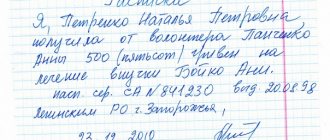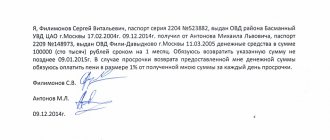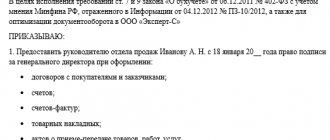Free legal consultation over the Internet 24 hoursLawyer on housing issues in St. Petersburg. Free legal consultation on labor disputes.
5/5 (3)
About the requirements for drawing up a document
A receipt drawn up by a notary must comply in content and form with the requirements established by law. Only in this case will the document be recognized as legally valid. When drawing up a receipt, the requirements of the law must not be violated.
Attention! The main requirements for compilation are:
- The document is drawn up by a citizen who borrows money. It must be written by hand. A receipt is confirmation that a person has received an item or a sum of money. You must write the text by hand in person. This will help to conduct an examination in the event of a trial;
- At the beginning of the text of the receipt, the passport details of all participants are indicated. They are completely copied from documents;
- If a person is temporarily given a thing for use, it must be described in detail in the text of the receipt, indicating its characteristics. When transferring the car, the engine number, make, year of manufacture and model of the vehicle are written down. When renting out an apartment, an inventory of the things in it is drawn up;
- Further, the text specifies the conditions under which a citizen receives an item for use, and the requirements for making a return. If money is transferred at interest, the text indicates the start date of accrual and the interest rate. The amount is written both in numbers and in letters;
- The date of compilation is indicated at the end of the document. This is a very important point, since legal documents have a statute of limitations. After three years there are no grounds for making demands. During the entire period, persons can go to court in case of conflict situations. The receipt will serve as documentary evidence;
- Both parties to the transaction sign the document and decipher the signatures.
The debt receipt does not need to be certified by a notary. This is done at the request of the citizen.
When drawing up a receipt, the passport of the citizen acting as the borrower must be checked. Any inaccuracy will lead to the deal being challenged in court.
Also, special attention should be paid to the return conditions. It is recommended that the receipt include a clause establishing liability in the event of non-return of the item or money.
The parties may invite witnesses when drawing up a receipt. This situation is not prohibited by civil law. But even the presence of witnesses will not give additional force to the document. Their testimony will be important if the situation goes to trial. Thanks to witnesses, it is possible to confirm under what circumstances and under what conditions the receipt was drawn up.
What does the price depend on?
As already written above, each notary a firmly established tariff It may be different in different regions. To this fixed amount is added a percentage of the loan equivalent or material value. The price for a certified receipt also depends on who orders the service - an individual or a legal entity. For a legal entity, the price will be higher, and besides, a simple receipt is not enough
In this case, you will have to draw up a real agreement, which, in addition to the main points, also contains additional ones. Such as:
- The reason for the transfer of material assets or funds.
- Number of the order or instruction on the basis of which the transfer occurs.
- Document's name.
- Manager's signature.
In addition, the receipt should indicate not only the amount of the debt, but also the interest on it, if any. In a situation where debt repayment will have to be sought through the court, the judge will be guided by the data from the receipt. Therefore, it is worthwhile to write everything down in the contract in advance.
Do I need to have a debt receipt certified by a notary?
The law does not stipulate that a receipt for a debt must be certified by a notary. This becomes mandatory if there are special circumstances approved by law. It is also not prohibited to contact a notary if both parties want it. Most often, the receipt is certified by agreement between the parties to the transaction.
Please note! If the document is drawn up correctly, in compliance with all norms, it will have legal force without notarization. Contacting a notary is an additional opportunity to insure yourself. Such a receipt cannot be challenged in court.
Will they give a loan if the bailiffs have a debt?
Whether the penalty can exceed the amount of the principal debt, read here.
Who is a loan donor, read the link:
How to do it
Now let's figure out how to certify a receipt from a notary, or rather, a signature, according to the rules. To do this, it is necessary that the person drawing up such a document, together with the person in whose name the paper is drawn up, personally visit the notary’s office. There, a document is drawn up in a standard form, but by hand. An example of what it might look like is below.
You must have a civil passport with you. Ideally, draw up a loan agreement, with which a specialist will definitely help. No witnesses required.
How to certify a receipt from a notary: algorithm of actions
The procedure for certification of a promissory note is carried out according to standard rules. Before it is certified, the receipt must be drawn up correctly, in accordance with all legal norms.
The receipt can only be certified by a notary. But at the request of the parties, witnesses can be invited to formalize the transaction. This will become additional insurance. Witnesses will be able to testify in court if problems arise with fulfilling the terms of the contract.
A receipt for the issuance and return of funds is drawn up in two copies. It contains the date and signatures of both parties. By signing, citizens prove that they have no claims against each other.
Attention! Our qualified lawyers will assist you free of charge and around the clock on any issues. Find out more here.
Not everyone can draw up a promissory note on their own, taking into account all the legal requirements. If difficulties arise, it is better to contact a lawyer for help in drawing up the document.
As soon as the receipt is ready, which complies with all the rules for drafting, the parties sign and the document is taken to the notary. After he reads the text and checks the data, the paper is certified. The notary puts his signature and seal.
Watch the video. Common misconceptions about IOUs:
Refund period
The refund period must be specified definitely and unquestionably. This may be writing a specific date by which the debt must be repaid, or the number of days, months, years from the date of the receipt. Only after the period for returning the money has expired, the creditor can go to court to collect the debt, so the determining condition for the court will be the content of a specific date in the receipt of funds. If there is no deadline for return, the court may assume that this period has not yet expired and refuse to consider the claim.
The debtor does not fulfill his obligations under the receipt: what to do
The parties do not always fulfill the conditions specified in the loan agreement. There are often cases when the party acting as the borrower cannot or does not want to fulfill its obligations and avoids repaying the debt.
In judicial practice, there are situations when the debtor denies that he borrowed money. This is due to the fact that the citizen is not aware of the legal force of the receipt.
If a party to a transaction is faced with a situation where they refuse to repay the debt, they need to formally demand the repayment. This must be done in writing and sent by registered mail with return receipt requested.
ATTENTION! Look at the completed sample pre-trial claim for debt collection by receipt:
Date of receipt and identification of debtor and creditor
The date of compilation is required. Firstly, when paying for services or work, the date will confirm when the payment was made. Secondly, when transferring money with the condition of return, from the date of drawing up the receipt, you can count the period after which the funds must be returned.
The debtor - the person accepting the money, indicates his full name, passport details, and address in the receipt for receiving the money. The recipient of the funds must be fully identified, because he is the defendant in the lawsuit. The person transferring the funds must also be indicated with a description of their full name and passport details. Its identification is no less important.
The procedure for collection through a notary
To find out how to collect a debt through a notary's writ of execution, you need to refer to the law on notaries. It describes the procedure for making an inscription and its content, as well as the features of notifying the defaulter.
If the procedure for collection through a notary is violated, you can appeal and cancel the inscription. The debtor also has the opportunity to present his objections before taking action.
Read more about this below.
Conditions
For a creditor, debt collection through a notary provides many advantages. First of all, the collection period is reduced, since there is no need to go to court and wait for the case to be completed and the decision to enter into force. There are also savings on costs, since the notary fee is less than the state fee for the court.
Since 2021, interacting with a notary has become even easier. The creditor can submit documents and receive an order for collection through the online services of the State Services and the Notary Chamber.
Making a writ of execution by a notary is permitted under the following conditions:
- if the debt is undeniable;
- if the documents contain a clause on the right to such a method of collection, or the transaction was previously certified by a notary;
- if the debt period is no more than 2 years;
- if the claimant notified the defaulter properly and provided relevant evidence;
- if the claimant has submitted all the necessary documents confirming the grounds for the debt, its size, and the period of delay.
At the moment, lenders rarely use this collection option. According to information from the website of the Federal Notary Chamber, about 50 thousand inscriptions were made in 2021. But the demand for this service will probably grow, since a remote procedure for applying to a notary has been introduced.
The lender can certify all documents with an electronic digital signature and send them to a notary, and receive a copy of the agreement with notarization via the Internet. Moreover, the notary has the right to send the document to the FSSP himself if the creditor requests this in the application.
Algorithm of actions
If the creditor has grounds for collection through a notary, he must act as follows:
- documents specified in the law on notaries are prepared
- this list includes an application, agreement, debt calculation; - a notification about the upcoming application to a notary is sent to the debtor’s address
- the letter must be sent no later than 14 days before applying to the notary; - documents related to the debt and evidence of sending the notice are transferred to the notary
- this can be done in person or through online services; - the notary checks all the conditions for collection and execution of the inscription
- if the debtor presents his objections, the notary is obliged to check and take them into account when performing the action; - if all the grounds for collection are confirmed, the notary makes an inscription on a copy of the contract
- at the same time a mark about the notarial action is placed on the original contract; - a record of the completed inscription is entered into the federal register of notarial acts
- the registry number must be indicated in the content of the inscription; - within three days, the notary is obliged to send a notice to the debtor
- the notary determines the form and content of the notice independently.
A separate register of notary's writs of execution is not maintained. Such data is entered into the federal register of notarial acts. Unfortunately, ordinary citizens are not yet able to check the information in this registry themselves. Only the register of inheritance cases is publicly available.
We will tell you in detail about the procedure for notifying the debtor. The creditor has the right to send a notice to the address specified in the agreement. If the borrower (debtor) has not provided information about the change of address, he runs the risk of not receiving a letter from the creditor.
The creditor is not required to prove that the debtor actually received the notice. Therefore, a situation may arise when the letter is sent to the old address, and the debtor learns about the notarial collection only from the bailiffs.
In this case, it is important to challenge the collection in time, since only 10 days are given for this. The period is counted from the day when the defaulter learned about the notarial action or should have learned about it.
Contents of the notarial inscription
Let's look at what a notary's inscription must contain according to the law. On the copy of the agreement, the notary must indicate:
- date and place of notarial act;
- information about the notary;
- data of the creditor and debtor;
- the period of time for which the debt was collected;
- the amount of money or property recovered from the debtor, including interest;
- registry number;
- signature, seal of a notary.
The content of the inscription is filled in according to the documents provided by the claimant. For example, a mandatory document from the creditor is the calculation of the amount of debt. Not only the amounts to be collected will be stated there, but also the period of delay.
The notary writes the above information on a copy of the contract. Its original is also checked when performing a notarial act. In this case, a mark is made on the original that an inscription about collection has been made.
This reduces the risk of fraud on the part of the creditor, since he will not be able to re-submit the document to another notary office and receive another order for collection.
How much does the lettering service cost?
As indicated on the website of the Federal Notary Chamber, before the introduction of electronic services for making inscriptions, the tariff was 1,500 rubles. After the introduction of digital notary services, the price of services decreased. Depending on the amount of debt, the lender will have to pay from 300 to 1000 rubles. When going to court, the fee will almost always be higher.
Contacting the FSSP
The law considers a notary's writ of execution as an executive document, on a par with a court order or writ of execution. This means that immediately after receiving the document at the notary’s office, the claimant can apply to the FSSP.
The period for presenting the document to the bailiffs is no more than 3 years. If the debtor and creditor are legal entities, the specified period will be only 1 year.
Based on the documents of the collector, the bailiff will begin the usual enforcement actions. The resolution to initiate the case will be sent to the debtor. If he has not previously received a notice from the creditor or a notice from a notary, the date of receipt of the FSSP decision determines the period for appealing the notarial actions.
A notary's writ of execution in enforcement proceedings allows the use of all methods of collection:
- deduction from salary at the place of work, pension or scholarship;
- seizure of bank accounts, debiting funds from them;
- arrest and sale of assets, introduction of prohibitions on the disposal of property;
- restrictions on the debtor, including deprivation of a driver’s license and a ban on travel abroad.
There is a special rule related to the replacement of a party in proceedings (for example, in the event of the death of the debtor). If the collection is carried out according to a writ of execution or a court order, you must go to court to replace the party. But when collecting by notarial order, the succession can be formalized by the bailiff himself, on his own initiative or at the request of the creditor.
What can suspend the limitation period?
In practice, the following cases occur when the limitation period is suspended.
- Force majeure (extraordinary circumstances that are considered insurmountable).
- The moratorium that the Russian Government has imposed on the fulfillment of these obligations.
- Service of the participants in the loan agreement in the Armed Forces (in case of their transfer to martial law).
- Adoption of a law suspending the effect of a normative legal act that regulates the relations of the parties to the receipt.
- The mediation procedure, if the parties have entered into such an agreement.
How can you sell a promissory note?
Even in a difficult situation, there is no need to lose heart. There is a collection community in the Russian Federation that has extensive experience in finding and collecting money from negligent borrowers. By contacting them, you may well be able to sell the debt. The bargaining amount starts from 10% of the debt amount; as a rule, collectors buy the debt for an amount not exceeding 50% of the debt amount.
What to do if the borrower suddenly died (died)
It is necessary to find out the availability of property, track who accepted this property - entered into an inheritance, and file a claim for repayment of the debt to the legal successor of the deceased borrower. Remember, property, like debts, is inheritable!
How much does certification cost?
The specific set price for certification of a receipt by a notary depends on the region of residence and the office itself. For example, if you look for how much a receipt certified by a notary costs in Moscow, you will find prices of about 2,000 rubles. Please note that in most cases the price depends on the amount in the certified document (usually from 0.3 to 1%). That is, the base rate is taken (in the case we are considering, 2000 rubles) and the agreed percentage is added to it. Of course, this only applies when it comes to transferring specific amounts of money. This is the most common case, but not the only one.
In St. Petersburg, prices are more or less similar to Moscow. At the same time, in the regions this point is somewhat simpler in terms of prices. It is rare when the amount exceeds 1.5 thousand rubles + interest.
About the author of the article
Alexander Kozyrev







